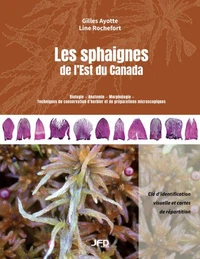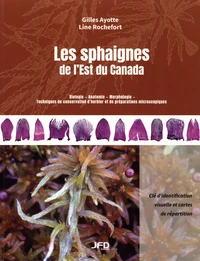Sphagnum Mosses of Eastern Canada. Biology — Anatomy — Morphology — Herbarium conservation techniques and microscopic preparations
Par : ,Formats :
Disponible dans votre compte client Decitre ou Furet du Nord dès validation de votre commande. Le format Epub fixed layout protégé est :
- Compatible avec une lecture sur My Vivlio (smartphone, tablette, ordinateur)
- Compatible avec une lecture sur liseuses Vivlio
- Pour les liseuses autres que Vivlio, vous devez utiliser le logiciel Adobe Digital Edition. Non compatible avec la lecture sur les liseuses Kindle, Remarkable et Sony
- Non compatible avec un achat hors France métropolitaine
 , qui est-ce ?
, qui est-ce ?Notre partenaire de plateforme de lecture numérique où vous retrouverez l'ensemble de vos ebooks gratuitement
Pour en savoir plus sur nos ebooks, consultez notre aide en ligne ici
- Nombre de pages272
- FormatEpub fixed layout
- ISBN978-2-89799-245-3
- EAN9782897992453
- Date de parution01/01/2021
- Protection num.Adobe DRM
- Taille64 Mo
- Infos supplémentairesepub
- ÉditeurÉditions JFD Inc
Résumé
Sphagnum mosses are small plants of the division of Bryophyta that are widespread and abundant in peatlands and several other types of wetlands. About sixty species of Sphagnum mosses are known for the territories of Quebec, Labrador and the Maritimes (with the exception of the island of Newfoundland). However, it can be laborious to identify these plants to the species taxonomic level. This book provides a unique dichotomous key for a visual iden- tification of Sphagnum mosses that will help to demystify the lingo used in botany.
To make it easier for identifiers, it also presents ways to recognize species in the field, notes about their habitats, and distribution maps. This document will be useful to ecologists, foresters, biologists and geographers involved in environmental management, as well as stakeholders responsible for managing the natural resources they protect or exploit. This guide is also intended as a tool for any naturalist or botanist working east of the Rockies, or in the Canadian Arctic.
The botanists of the United States will find this document useful for the Sphagnum mosses found in Northern States or in the region of New England.
To make it easier for identifiers, it also presents ways to recognize species in the field, notes about their habitats, and distribution maps. This document will be useful to ecologists, foresters, biologists and geographers involved in environmental management, as well as stakeholders responsible for managing the natural resources they protect or exploit. This guide is also intended as a tool for any naturalist or botanist working east of the Rockies, or in the Canadian Arctic.
The botanists of the United States will find this document useful for the Sphagnum mosses found in Northern States or in the region of New England.
Sphagnum mosses are small plants of the division of Bryophyta that are widespread and abundant in peatlands and several other types of wetlands. About sixty species of Sphagnum mosses are known for the territories of Quebec, Labrador and the Maritimes (with the exception of the island of Newfoundland). However, it can be laborious to identify these plants to the species taxonomic level. This book provides a unique dichotomous key for a visual iden- tification of Sphagnum mosses that will help to demystify the lingo used in botany.
To make it easier for identifiers, it also presents ways to recognize species in the field, notes about their habitats, and distribution maps. This document will be useful to ecologists, foresters, biologists and geographers involved in environmental management, as well as stakeholders responsible for managing the natural resources they protect or exploit. This guide is also intended as a tool for any naturalist or botanist working east of the Rockies, or in the Canadian Arctic.
The botanists of the United States will find this document useful for the Sphagnum mosses found in Northern States or in the region of New England.
To make it easier for identifiers, it also presents ways to recognize species in the field, notes about their habitats, and distribution maps. This document will be useful to ecologists, foresters, biologists and geographers involved in environmental management, as well as stakeholders responsible for managing the natural resources they protect or exploit. This guide is also intended as a tool for any naturalist or botanist working east of the Rockies, or in the Canadian Arctic.
The botanists of the United States will find this document useful for the Sphagnum mosses found in Northern States or in the region of New England.






